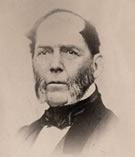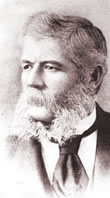|
Last change
October 27, 2019
During the decade preceding Confederation, the Canadian oil industry
was born. The high cost of whale oil as a luminant, $2.50 per gallon or thereabout (in the mid 1800s), prompted the search for a cheaper substitute. The early work of Abraham Gesner and others directed attention to crude oil obtained from seepages and from the so-called "gum" beds which were fairly common in New York, Pennsylvania, Ontario and other eastern regions.
Gesner and Williams: two Canadians who launched the world's petroleum industry - by Earle Gray (reproduced with the author's permission) 12-page PDF, 149k
| 1846 |
 Abraham Gesner of Nova Scotia developed a refining process that transmuted coal, natural tar, and eventually oil into an illuminating fuel which he called kerosene. Of equal importance, he helped found the world's first refinery - an operation that extracted kerosene from coal. In the move from whale oil lamps to petroleum lighting, this was a critical development. Until the first World War, most refined oil simply burned in lamps and Gesner's work lit homes and factories throughout the world. Abraham Gesner of Nova Scotia developed a refining process that transmuted coal, natural tar, and eventually oil into an illuminating fuel which he called kerosene. Of equal importance, he helped found the world's first refinery - an operation that extracted kerosene from coal. In the move from whale oil lamps to petroleum lighting, this was a critical development. Until the first World War, most refined oil simply burned in lamps and Gesner's work lit homes and factories throughout the world.
This photograph of Abraham Gesner, is circa 1870.
Accession
number X10722
Used here with permission of the New Brunswick Museum, Saint John, N.B.
(On April 5, 1842, Dr. Abraham Gesner opened the Museum of Natural History, the original precursor of the New Brunswick Museum. It housed his collection of rocks, minerals, fossils, etc., and survives as one of Canada's oldest geological collections.)
See article called Gesner's Museum of Natural History, An Early Canadian Geological Collection by Randall F. Miller and Diane N. Buhay, published in Geoscience Canada 2007 March Volume 34 No. 1, on the Geological Association of Canada's website. |
| 1853 |
Gesner went to the United States where his kerosene patent (dated March 27, 1855) launched the North American Kerosene Gas and Lighting Company in 1854. Their refinery on Long Island produced kerosene from coal (or coal oil as kerosene is sometimes still called).
Canada post has twice honored Gesner with a commemorative stamp:
-
March 17, 2000 46 cent stamp
Title: Abraham Gesner: Father of the Oil Industry
Series: The Millennium Collection, Fathers of Invention
-
June 17, 1988 37 cent stamp
Title: Kerosene, 1846
Series: Canada Day - Science and Technology, Canadian Innovations in Energy, Food, Research and Medicine
More about Abraham Gesner online:
Photo of government-erected monument to Gesner at Chipman Corner in Kings County, Nova Scotia:
http://www.newscotland1398.net/kingsco/gesnermem.html
"Abraham Gesner saved more whales than Greenpeace ever will"
Essay - How Capitalism Saved the Whales by James S. Robbins.
including photo of Gesner monument erected by the Government of Canada's Historic Sites and Monuments Board:
www.littletechshoppe.com/ns1625/gesner.html
Abraham Pineo Gesner on Wikipedia:
http://en.wikipedia.org/wiki/Abraham_Pineo_Gesner
Gesner in Dictionary of Canadian Biography Online
Library and Archives of Canada:
http://www.biographi.ca/EN/ShowBio.asp?BioId=38570
Gesner on Virtual American Biographies website (scroll down on page for bio):
http://famousamericans.net/abrahamgesner/
Gesner's kerosene patent was dated March 27, 1855. At Brainy History you can see what else happened in 1855, or on March 27 in other years:
http://brainyhistory.com/events/1855/march_27_1855_53292.html
Books:
- Gesner's Dream:The Trials and Triumphs of Early Mining in New Brunswick by G.L. Martin at the Geological Association of Canada's online bookstore.
- Micham, Allison. Prophet of the Wilderness: Abraham Gesner. Hantsport,
Nova Scotia, Lancelot press, 1995.
- Barkhouse, Joyce. Abraham Gesner. Toronto. Fitzhenry and Whiteside, 1980.
- Beaton, Kendall. Dr. Gesner’s kerosene: the start of the American oil
refining business. Business history review, New York, March 1995.
- Gesner, Abraham. A practical treatise on coal, petroleum, and other
distilled oils. New York. Baillie bros., 1861.
- Gray, Earle. The Great Canadian Oil Patch: The Petroleum Era From Birth
To Peak -- chapter one. Calgary: Junewarren Publishing, 2005.
|
| 1851 |
Charles Nelson Tripp of Woodstock, Ontario, joined with his brother and businessmen from Hamilton and New York City to form the International Mining and Manufacturing Company for the purpose of producing asphalt from the Ontario gum beds situated in Enniskillen Township. This was the first oil company formed in North America. Its charter empowered the company to explore for asphalt beds and oil and salt springs, and to manufacture oils, naphtha paints, burning fluids, varnishes and related products.
Charles Nelson Tripp in the Canadian Petroleum Hall of Fame
http://www.canadianpetroleumhalloffame.ca/charles-tripp.html |
| 1856 |
 James Miller Williams, a manufacturer of railway carriages at Hamilton, bought Tripp's land and oil rights. Tripp stayed on the payroll as landman. James Miller Williams, a manufacturer of railway carriages at Hamilton, bought Tripp's land and oil rights. Tripp stayed on the payroll as landman.
Photograph of James Miller Williams
Used here with permission of the Oil Museum of Canada
Oil Springs, Lambton County, Ontario
More about James Miller Williams online:
James Miller Williams at Wikipedia:
http://en.wikipedia.org/wiki/James_Miller_Williams
Williams in Dictionary of Canadian Biography Online
Library and Archives of Canada:
http://www.biographi.ca/EN/ShowBio.asp?BioId=40028
James Miller Williams in the Canadian Petroleum Hall of Fame
http://www.canadianpetroleumhalloffame.ca/james-williams.html
Petrolia Heritage/ Oil Springs website:
http://www.petroliaheritage.com/oilSprings.htm |
| 1857 |
James M. Williams formed the J.M.Williams Company. After unsuccessful attempts at commercial production from the gum beds Williams hand-dug and cribbed a well 49 feet deep. It did not reach bedrock but produced as much as 150 gallons per hour by hand pump. The oil was refined for illuminating oil and lubricants.
|
| 1858 |
Stagnant algae-ridden water lay almost everywhere and, looking for better drinking water, Williams dug a well a few yards down an incline from his asphalt plant. At a depth of 20 metres, the well struck free oil instead of water.
In 1858 it became the first oil well in North America, remembered as Williams No.1 at Oil Springs, Ontario. (This was a year before Edwin Drake drilled his famous wildcat in Pennsylvania in 1859.)
The Oil Museum of Canada was founded on the site of the first commercial oil well in North America, and a replica is on display at the museum.
|
| 1860 |
Williams eventually abandoned his Oil Springs refinery and transferred his operations to Hamilton, Ontario. In 1860, the local newspaper carried his ad: "Coal oil for sale, 16 cents per gallon for quantities from 4000 to 100 000 gallons." Willimas reincorporated his firm as The Canadian Oil Company and operated facilities for petroleum production, refining and marketing - a mix that qualifies his company as the first integrated oil company in the world.
|
| 1862 |
On February 19, 1862, Hugh Nixon Shaw of Cooksville, Ontario, struck oil at 48 metres at Oil Creek, Enniskillen County, Ontario. This was Canada's first gusher, estimated to be good for 3,000 barrels per day.
|
| 1870 |
By 1870 Canada was exporting oil to Europe and had about 100 refineries in operation.
|
References:
| Author |
Book |
| George de Mille |
Oil in Canada West, The Early Years
© 1969 |
| James D. Hilborn,
editor |
Dusters and Gushers, The Canadian Oil and Gas Industry
© 1968
Chapter: Canadian Oil Pioneers
by George Lonn |
Peter McKenzie-Brown,
Gordon Jaremko,
David Finch |
The Great Oil Age
© 1993 The Petroleum History Society |
| Earle Gray |
The Great Canadian Oil Patch (Second Edition)
The Petroleum Era from Birth to Peak
© 2005
JuneWarren Publishing Ltd. |
| Robert Bott |
Evolution of Canada's Oil and Gas Industry
© 2004 Canadian
Centre for Energy Information
Writer: Robert D. Bott
Editors: David M. Carson, MSc and
Jan W. Henderson, APR, MCS |
| Allison Mitcham |
The Prophet of the Wilderness: Abraham Gesner
© 1995 Lancelot Press, Hantsport NS |
| The websites linked above were also used as references. |
Page prepared by Micky Gulless. Thanks to reviewers Earle Gray and Robert Bott.
|

